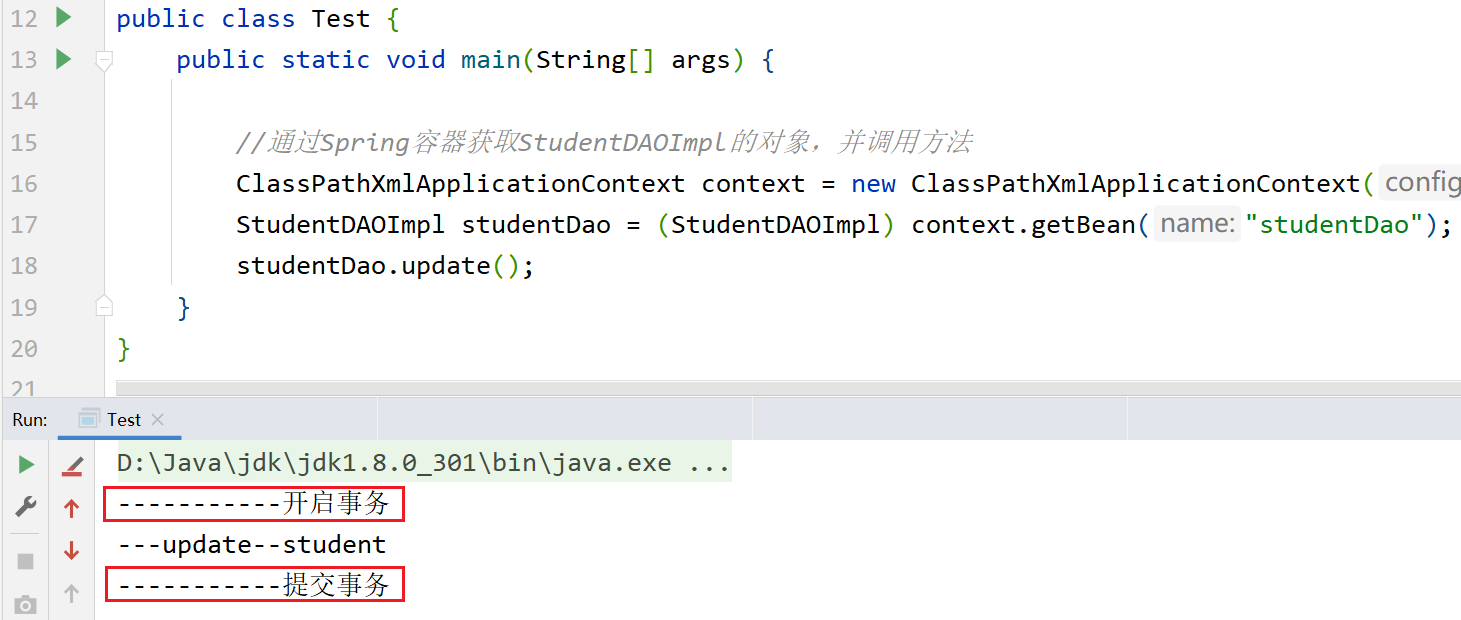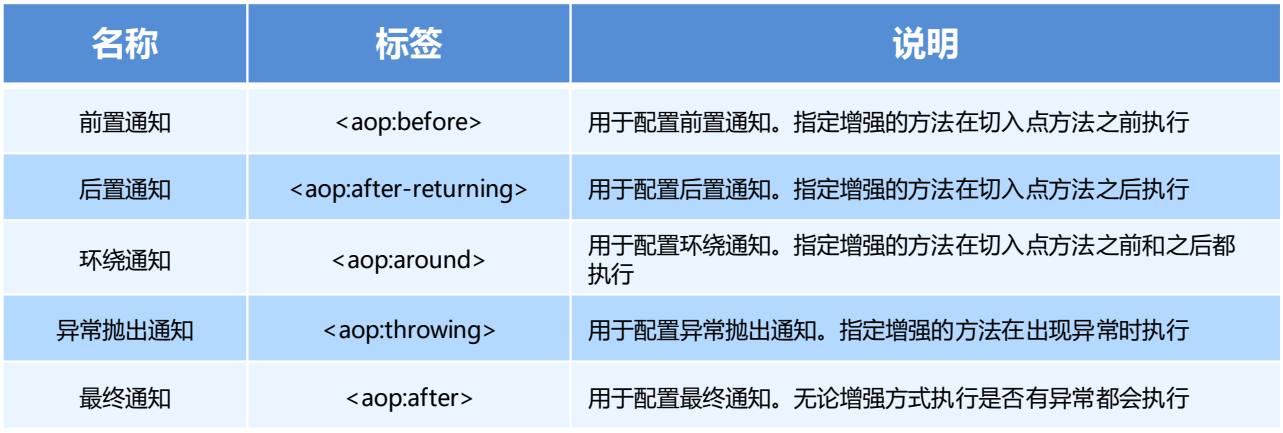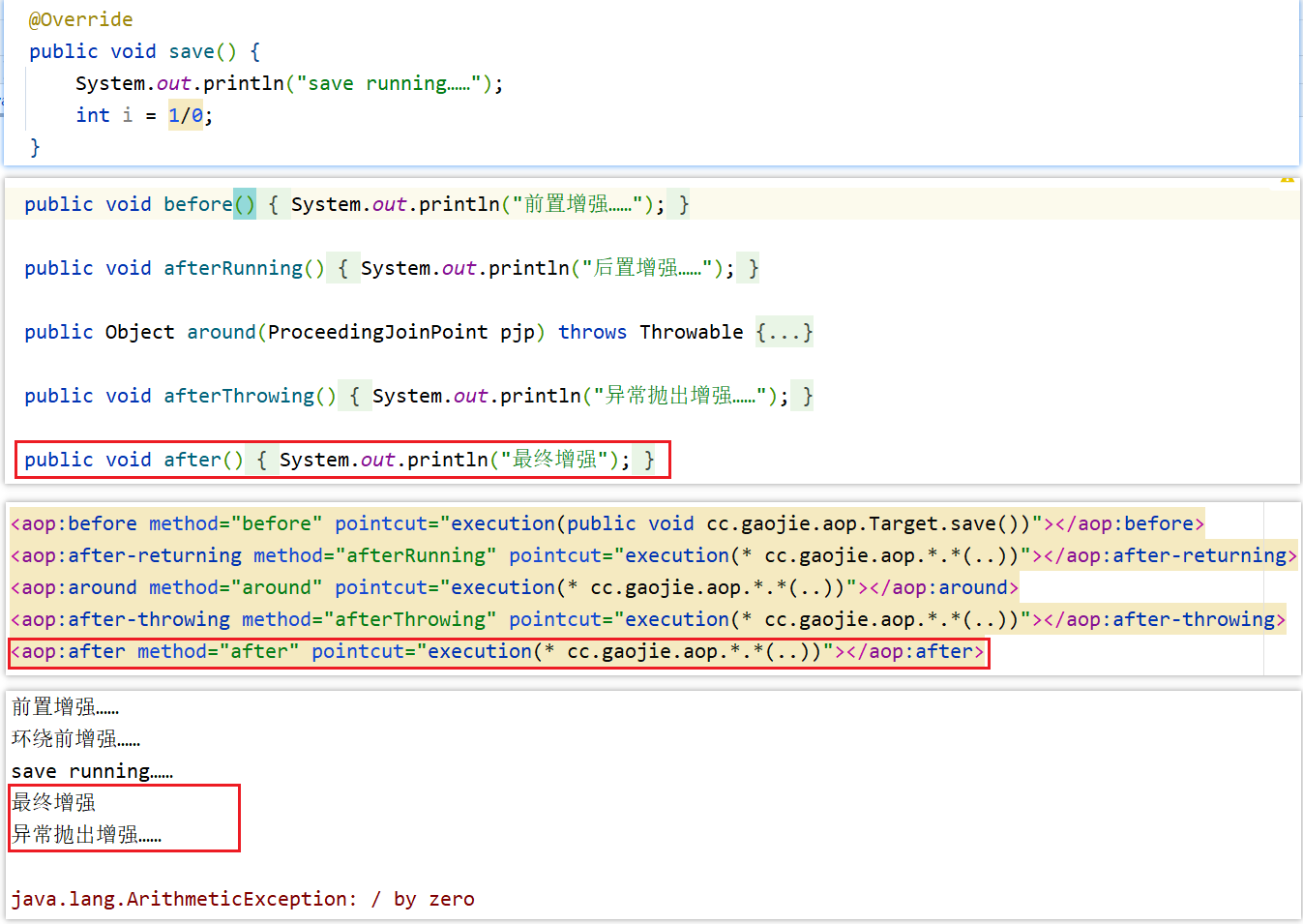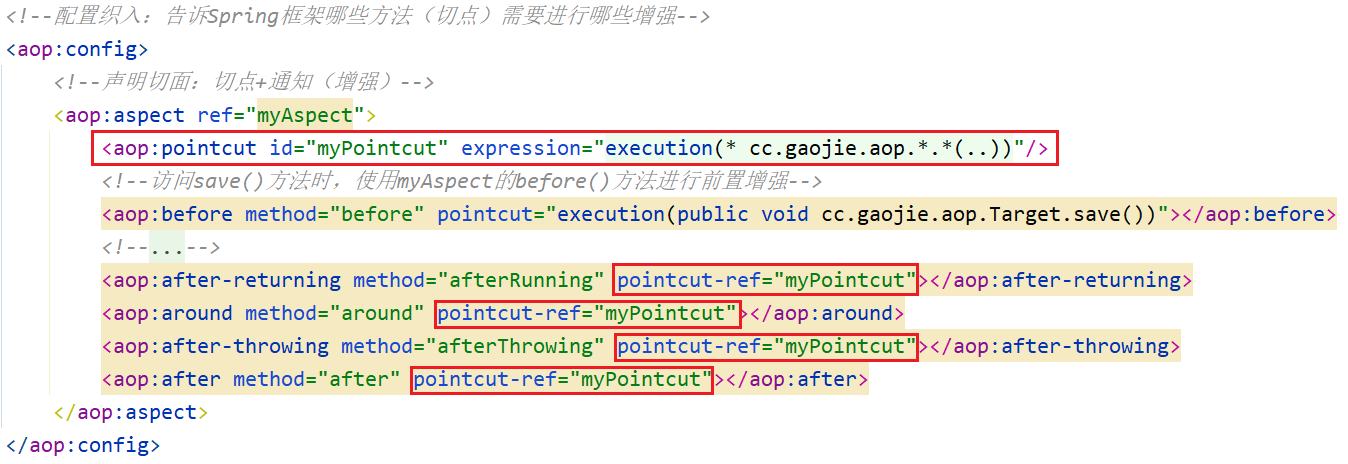基于XML的AOP开发
本文最后更新于:1 年前
AOP开发步骤:
创建切面类,在切面类定义切点方法
将切面类配置给Spring容器
声明切入点
配置AOP的通知策略
如果要使用Spring aop面向切面编程,调用切入点方法的对象必须通过Spring容器获取:
- 如果一个类中的方法被声明为切入点并且织入了切点之后,通过Spring容器获取该类对象,实则获取到的是一个代理对象;
- 如果一个类中的方法没有被声明为切入点,通过Spring容器获取的就是这个类真实创建的对象。
AOP开发步骤
创建切面类,在切面类定义切点方法
将切面类配置给Spring容器
声明切入点
配置AOP的通知策略
案例一
1. 添加依赖
- context
- aspects
1 | |
2. 创建目标接口和目标类(内部有切点)
| StudentDAOImpl.java |
|---|
 |
3. 创建一个类,定义要添加的业务逻辑
1 | |
4. 创建spring配置文件,配置aop
引入aop的命名空间,在DAO的方法添加开启事务和提交事务的逻辑。
1 | |
5. 测试

案例二
1. 导入 AOP 相关坐标
- context
- aspects
1 | |
2. 创建目标接口和目标类(内部有切点)
1 | |
1 | |
3. 创建切面类(内部有增强方法)
1 | |
4. 将目标类和切面类交给Spring管理
1 | |
5. 在 applicationContext.xml 中配置织入关系
1 | |
6. 测试代码
1 | |

切入点的声明
切点表达式的写法
1 | |
- 访问修饰符可以省略。
- 返回值类型、包名、类名、方法名可以使用星号
*代表任意。 - 包名与类名之间一个点
.代表当前包下的类;两个点..表示当前包及其子包下的类。 - 参数列表可以使用两个点
..表示任意个数,任意类型的参数列表。

1 | |
通知策略
AOP通知策略:就是声明将切面类中的切点方法如何织入到切入点
- before
- after
- after-throwing
- after-returning
- around
1 | |

案例一




可以看到,只有【异常抛出通知】和【最终通知】遇到异常后会继续执行。
案例二
定义切面类
1
2
3
4
5
6
7
8
9
10
11
12
13
14
15
16
17
18
19
20
21
22
23
24
25
26
27
28
29public class MyAspect {
public void method1(){
System.out.println("~~~~~~~method1");
}
public void method2(){
System.out.println("~~~~~~~method2");
}
public void method3(){
System.out.println("~~~~~~~method3");
}
public void method4(){
System.out.println("~~~~~~~method4");
}
//环绕通知的切点方法,必须准守如下的定义规则:
//1.必须带有一个ProceedingJoinPoint类型的参数
//2.必须有Object类型的返回值
//3.在前后增强的业务逻辑之间执行Object v = point.proceed();
//4.方法最后返回v
public Object method5(ProceedingJoinPoint point) throws Throwable {
System.out.println("~~~~~~~method5---before");
//此代码的执行,就表示切入点方法的执行
Object v = point.proceed();
System.out.println("~~~~~~~method5---after");
return v;从
}
}配置切面类
1
2
3
4
5
6
7
8
9
10
11
12
13
14
15
16
17
18
19<bean id="myAspect" class="com.qfedu.utils.MyAspect"></bean>
<aop:config>
<!--使用aop:pointcut标签声明切入点:切入点可以是一个方法-->
<aop:pointcut id="book_insert" expression="execution(* com.qfedu.dao.BookDAOImpl.insert())"/>
<aop:aspect ref="myAspect">
<!--aop:before 前置通知,切入到指定切入点之前-->
<aop:before method="method1" pointcut-ref="book_insert"/>
<!--aop:after 后置通知,切入到指定切入点之后-->
<aop:after method="method2" pointcut-ref="book_insert"/>
<!--aop:after-throwing 异常通知,切入点抛出异常之后-->
<aop:after-throwing method="method3" pointcut-ref="book_insert"/>
<!--aop:after-returning 方法返回值返回之后,对于一个Java方法而言return返回值也是方法的一部分
因此“方法返回值返回之后”和“方法执行结束”是同一个时间点,after 和 after-returning根据配置的顺序决定执行顺序-->
<aop:after-returning method="method4" pointcut-ref="book_insert"/>
<aop:around method="method5" pointcut-ref="book_insert"/>
</aop:aspect>
</aop:config>运行结果

切点表达式的抽取
当多个增强的切点表达式相同时,可以将切点表达式进行抽取,在增强中使用 pointcut-ref 属性代替 pointcut 属性来引用抽取后的切点表达式。(便于维护)

AOP使用注意事项
如果要使用Spring aop面向切面编程,调用切入点方法的对象必须通过Spring容器获取。
- 如果一个类中的方法被声明为切入点并且织入了切点之后,通过Spring容器获取该类对象,实则获取到的是一个代理对象;
- 如果一个类中的方法没有被声明为切入点,通过Spring容器获取的就是这个类真实创建的对象。
知识要点
AOP开发步骤
创建切面类,在切面类定义切点方法
将切面类配置给Spring容器
声明切入点
配置AOP的通知策略
aop织入的配置
1 | |
通知的类型
前置通知、后置通知、环绕通知、异常抛出通知、最终通知。
只有【异常抛出通知】和【最终通知】遇到异常后会继续执行。
切点表达式的写法
1 | |
- 访问修饰符可以省略。
- 返回值类型、包名、类名、方法名可以使用星号
*代表任意。 - 包名与类名之间一个点
.代表当前包下的类;两个点..表示当前包及其子包下的类。 - 参数列表可以使用两个点
..表示任意个数,任意类型的参数列表。
AOP使用注意事项
如果要使用Spring aop面向切面编程,调用切入点方法的对象必须通过Spring容器获取。
- 如果一个类中的方法被声明为切入点并且织入了切点之后,通过Spring容器获取该类对象,实则获取到的是一个代理对象;
- 如果一个类中的方法没有被声明为切入点,通过Spring容器获取的就是这个类真实创建的对象。
本博客所有文章除特别声明外,均采用 CC BY-SA 4.0 协议 ,转载请注明出处!